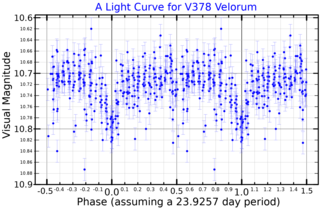
T Coronae Borealis, is a recurring nova in the constellation Corona Borealis. It was first discovered in outburst in 1866 by John Birmingham, although it had been observed earlier as a 10th magnitude star.

Wolf 1061 is an M-class red dwarf star located about 14.1 light-years away in the constellation Ophiuchus. It is the 36th-closest-known star system to the Sun and has a relatively high proper motion of 1.2 seconds of arc per year. Wolf 1061 does not have any unusual spectroscopic features.

74 Aquarii is a triple star system in the constellation of Aquarius. 74 Aquarii is its Flamsteed designation and it also bears the variable star designation HI Aquarii. The combined apparent visual magnitude is 5.8, although it is very slightly variable, and it is located at a distance of 590 light-years from Earth.
Z Andromedae is a binary star system consisting of a red giant and a white dwarf. It is the prototype of a type of cataclysmic variable star known as symbiotic variable stars or simply Z Andromedae variables. The brightness of those stars vary over time, showing a quiescent, more stable phase and then an active one with a more pronounced variability and stronger brightening and/or dimming.

V Aquilae is a carbon star and semiregular variable star in the constellation Aquila. It has an apparent magnitude which varies between 6.6 and 8.4 and is located around 400 parsecs (1,300 ly) away.

R Aquarii is a variable star in the constellation Aquarius.

A symbiotic binary is a type of binary star system, often simply called a symbiotic star. They usually contain a white dwarf with a companion red giant. The cool giant star loses material via Roche lobe overflow or through its stellar wind, which flows onto the hot compact star, usually via an accretion disk.

V380 Ori is a young multiple star system located near the Orion Nebula in the constellation Orion, thought to be somewhere between 1 and 3 million years old. It lies at the centre of NGC 1999 and is the primary source lighting up this and other nebulae in the region.

Gliese 208 is a red dwarf star with an apparent magnitude of 8.9. It is 37 light years away in the constellation of Orion. It is an extremely wide binary with 2MASS J0536+1117, an M4 star 2.6 arcminutes away

HD 110432 is a Be star in the south-east of Crux, behind the center of the southern hemisphere's dark Coalsack Nebula. It has a stellar classification of B1IVe, which means it is a subgiant star of class B that displays emission lines in its spectrum. This is a variable star of the Gamma Cassiopeiae type, indicating it is a shell star with a circumstellar disk of gas about the equator, and has the variable star designation BZ Crucis. It is not known to be a member of a binary system, although it is probably a member of the open cluster NGC 4609. This star is moderately luminous in the X-ray band, with a variable energy emission of 1032–33 erg s−1 in the range 0.2−12 keV. The X-ray emission may be caused by magnetic activity, or possibly by accretion onto a white dwarf companion.
106 Herculis is a variable star in the northern constellation Hercules. It is visible to the naked eye as a faint, red-hued point of light with a baseline apparent visual magnitude of 4.96. Based on its parallax, it is estimated to lie 383 light-years away from the Sun. The star is moving closer to the Earth with a heliocentric radial velocity of -35 km/s.
Mu Muscae, Latinized from μ Muscae, is a solitary star in the southern constellation of Musca. It is visible to the naked eye as a faint, orange-hued star with an apparent visual magnitude of around 4.75. Based upon an annual parallax shift of 7.21 mas as seen from Earth, it is located about 450 light years from the Sun. The star is drifting further away with a radial velocity of +37 km/s.

Y Centauri or Y Cen is a semiregular variable star in the constellation of Centaurus.

Gliese 908 is a red dwarf star, located in constellation Pisces at 19.3 light-years from Earth. It is a BY Draconis variable star with a variable star designation of BR Piscium. Its apparent magnitude varies between magnitude 8.93 and magnitude 9.03 as a result of starspots and varying chromospheric activity.

DD Microscopii, also known as CD−43°14304, is a binary star system in the constellation Microscopium. The system has a combined average apparent magnitude around 11, making it readily visible in telescopes but not to the naked eye. It is thought to be at a distance of one or two thousand parsecs, although parallax measurements place the system at a distance of around 30,000 light years.

IK Tauri or NML Tauri is a Mira variable star located about 280 parsecs (910 ly) from the Sun in the zodiac constellation of Taurus.

WR 12 is a spectroscopic binary in the constellation Vela. It is an eclipsing binary consisting of a Wolf-Rayet star and a luminous companion of unknown spectral type. The primary is one of the most luminous stars known.

IRAS 08544−4431 is a binary system surrounded by a dusty ring in the constellation of Vela. The system contains an RV Tauri variable star and a more massive but much less luminous companion.

V392 Persei, also known as Nova Persei 2018, is a bright nova in the constellation Perseus discovered on April 29, 2018. It was previously known as a dwarf nova.

CH Cygni is a red giant, variable, symbiotic binary in the constellation Cygnus. It is the nearest symbiotic star to Earth, and one of the brightest, making it an ideal candidate for study.

















